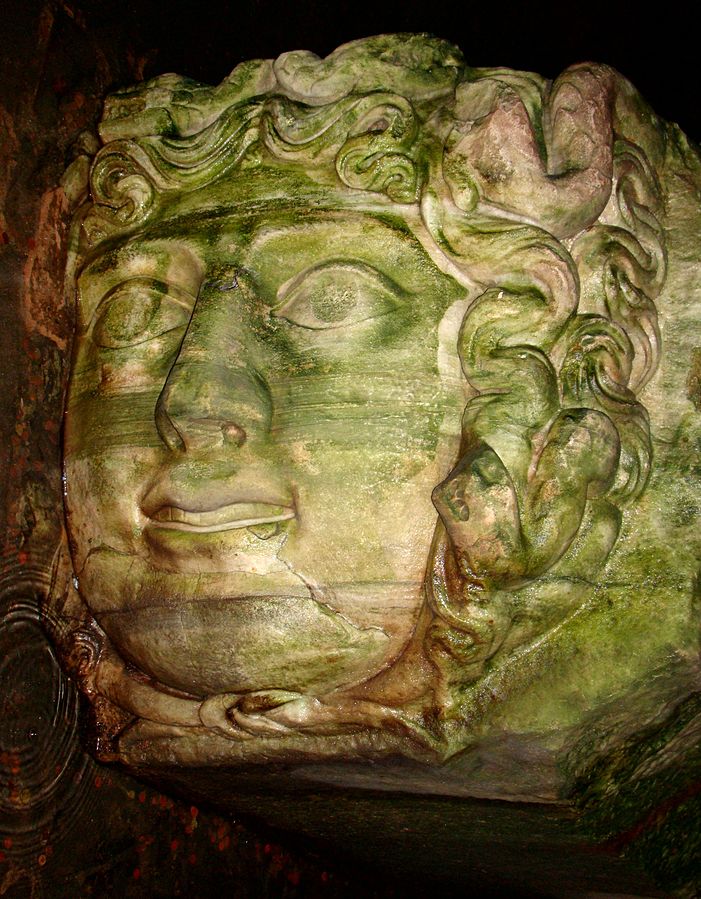You may have read in the Turkish news recently that archaeologists in Antalya found the head of Medusa … in stone.
The archaeologists told reporters the Medusa head was found among marble blocks, apparently a bas relief, and it was part of the façade of an ancient temple located at the site.
This heady discovery got me thinking about the old gal. We all had our share of Greek and Roman mythology in school. We all read about Medusa, that fetching wench with only a few flaws, one of them being the penchant for turning all who look at her to stone.
We watched Clash of the Titans. Who can forget handsome, swashbuckling Harry Hamlin as Perseus, and that great scene where he tricks a wonderfully terrifying claymation Medusa into looking at her own reflection in his shield? Her devilish looks turned upon her, our girl calcifies, and Handsome Harry chops her snaky head off. Nice one, Harry.
I shared the news of the Antalya find on Facebook, prompting a Turkish friend to comment: “In Turkish, if a girl is really hot, we say taş gibi.” Like a stone.

When you think about it, this phrase illustrates again how perspectives in this part of the world bear a subtle counter-reflection to ours in the West. In other words, we were always brought up to see Medusa as ugly, and that she turned men to stone. Most likely, Turks are taught the same in schools. But in the colloquial sense, it is the woman herself that is the stone. The object, rather than the perceiver, is changed.
The question begs: Does that mean that men are the Medusa?
Does the sight of a beautiful woman, seen through the staring eyes of her drooling admirer, make the man so ugly that it turns the woman to stone? Don’t answer that.
But seriously. Maybe we’ve misunderstood old Medusa all these years; or rather, we have misperceived her. For instance, the images we see always depict her with snakes in her hair. Maybe they were dreadlocks. Was Medusa a hippie? If so, did she smoke the doobage? If so, then perhaps all the guys who happened to cross her path caught a whiff of some really honest, underworld herb. The results were inevitable: They all got stoned.
That could account for some perceptions, at least.
But in any case, why has Medusa always been vilified?
I have developed a modest theory about this, having done thorough research, including a whole 30 seconds on Wikipedia.
In case you’ve forgotten, Medusa was actually one of three sisters (the other two being Stheno and Eurayle – why don’t we ever hear of those two? It seems a bit unfair, Medusa getting all the attention). They were descendants of “monsters of the chthonian world.” But wait! Scrolling further down the Wikipedia page, I see there were three more sisters, the Grey Sisters. These dainty dames shared one eye and one tooth among them (charming).
Aeschylus wrote of the Gorgon sisters as such:
Near them their sisters three, the Gorgons, winged
With snakes for hair— hatred of mortal man—
Hatred of mortal man – hmph. Well, I wonder why they hated us guys so much? What did we ever do to them? Maybe, as I said before, they got sick and tired of being stared at. “The problem with these mortals,” Medusa tells her sisters, “is every time we see one they seem to act like complete and utter morons!”
“Really!” enjoins Stheno. “One would think they’d never seen a Gorgon before!”
“One wonders if we weren’t made of stone,” agrees Eurayle.
So there it is, my modest contribution to the world of antiquity, resolving this matter of Medusa (and her sisters) once and for all. But the archaeologists in Antalya say more work remains to be done. I shall wait in earnest for their findings.
As I finished writing this, another friend, this one from England, offered his own point of view. After looking at the photograph of the stone Medusa head found in Antalya, he wryly remarked:
“I’ve been with worse.”
James Tressler is a writer whose books include, “The Trumpet Fisherman and Other Istanbul Sketches,” and “Letters from Istanbul, Vols. 1 and 2.” He lives in Koşuyolu.
Featured Image Source – “Basilica Cistern Medusa Rotated” by Bjørn Christian Tørrissen – Licensed under CC BY-SA 3.0 via Wikimedia Commons










